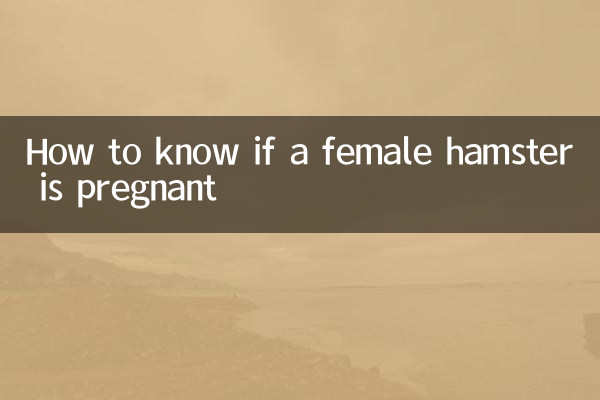How to know if a female hamster is pregnant
Hamsters are common pets with strong reproductive capabilities, but signs of pregnancy in female hamsters are often difficult to detect. It is crucial for breeders to promptly identify whether a female hamster is pregnant so that appropriate care can be provided. This article will introduce in detail how to determine whether a female hamster is pregnant from multiple aspects, and provide structured data to help you quickly grasp key information.
1. Common signs of pregnancy in female hamsters

After a female hamster becomes pregnant, her body and behavior will undergo a series of changes. The following are common signs of pregnancy:
| Sign type | Specific performance |
|---|---|
| weight gain | After pregnancy, the female hamster will gain significant weight, especially in the abdominal area. |
| Belly bulge | In the middle and late stages of pregnancy, the abdomen will gradually become larger and the pups can be felt when touched. |
| Increased food intake | Mother hamsters will eat frequently to store more energy to support fetal development. |
| behavioral changes | May become more alert or irritable, with increased nesting behavior. |
| Nipple protrusion | Later in pregnancy, the nipples will become obvious, especially in first-time pregnant female hamsters. |
2. How to confirm that a female hamster is pregnant
If you suspect that your female hamster is pregnant, you can further confirm by the following methods:
| method | Operating Instructions |
|---|---|
| touch check | Gently touch the abdomen. If you feel lumps or small particles, it may be the fetus. |
| Observe behavior | Pay attention to whether it frequently takes bedding materials to build nests or shows aggression. |
| weight monitoring | Weigh yourself regularly. If you continue to gain weight, it may be a sign of pregnancy. |
| veterinary diagnosis | If you are not sure, you can take it to the pet hospital for confirmation by ultrasound. |
3. Care points for pregnant female hamsters
Once the female hamster is confirmed to be pregnant, special attention should be paid to the following points:
| Nursing matters | Specific measures |
|---|---|
| diet modification | Provide high-protein foods, such as mealworms, eggs, etc., to supplement nutrition. |
| Quiet environment | Reduce disturbance to prevent the female hamster from miscarrying due to stress. |
| Sufficient padding material | Provide soft bedding materials to facilitate nesting for female hamsters. |
| Raising in separate cages | If you are in the same cage with a male hamster, you need to separate them immediately to prevent re-mating. |
4. Pregnancy cycle and childbirth preparation
Hamsters have a shorter pregnancy cycle, usually 16-22 days. As delivery approaches, female hamsters will exhibit more obvious nesting behavior and may refuse to eat. At this time, ensure that the cage is clean and that adequate food and water are provided.
5. Postpartum precautions
After the mother hamster gives birth, special attention should be paid to the following points:
| Things to note | specific suggestions |
|---|---|
| avoid disturbing | Try not to touch the cubs within a week after giving birth to prevent the mother from abandoning them. |
| Nutritional supplements | Continue to provide high-protein food to help the female hamster regain its strength. |
| clean environment | Clean the cage regularly, but avoid disturbing the mother hamster and pups frequently. |
Through the above methods, you can more accurately determine whether the female hamster is pregnant and provide appropriate care. If you still have questions, it is recommended to consult a professional veterinarian.

check the details

check the details